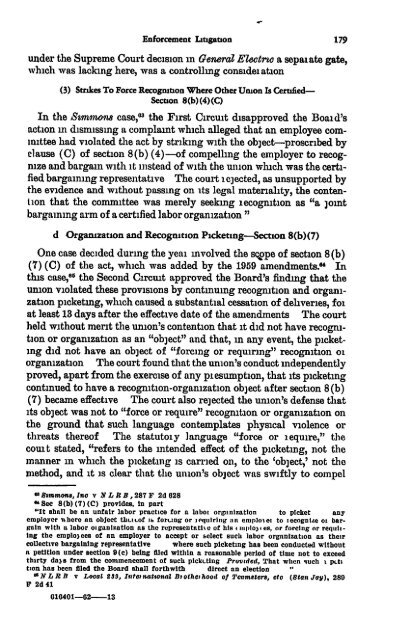TWENTY-SIXTH ANNUAL REPORT - National Labor Relations Board
TWENTY-SIXTH ANNUAL REPORT - National Labor Relations Board
TWENTY-SIXTH ANNUAL REPORT - National Labor Relations Board
Create successful ePaper yourself
Turn your PDF publications into a flip-book with our unique Google optimized e-Paper software.
Enforcement Litigation 179<br />
under the Supreme Court decision in General Electric a sepal ate gate,<br />
which was lacking here, was a controlling considei ation<br />
(3) Strikes To Force Recognition Where Other Union Is Certified—<br />
Section 8(b) (4)(C)<br />
In the S2711M0918 case,°3 the First Circuit disapproved the Boaid's<br />
action in dismissing a complaint which alleged that an employee committee<br />
had violated the act by striking with the object—proscribed by<br />
clause (C) of section 8(b) (4)—of compelling the employer to recognize<br />
and bargain with it instead of with the union which was the certified<br />
bargaining representative The court i ejected, as unsupported by<br />
the evidence and without passing on its legal materiality, the contention<br />
that the committee was merely seeking lecognition as "a joint<br />
bargaining arm of a certified labor organization"<br />
d Organization and Recognition Picketing—Section 8(b)(7)<br />
One case decided during the yea]. involved the svpe of section 8(b)<br />
(7) (C) of the act, which was added by the 1959 amendments." In<br />
this case," the Second Circuit approved the <strong>Board</strong>'s finding that the<br />
union violated these provisions by continuing recognition and organization<br />
picketing, which caused a substantial cessation of deliveries, foi<br />
at least 13 days after the effective date of the amendments The court<br />
held without merit the union's contention that it did not have recognition<br />
or organization as an "object" and that, in any event, the picketing<br />
did not have an object of "forcing or requiring" recognition oi<br />
organization The court found that the union's conduct independently<br />
proved, apart from the exercise of any piesumption, that its picketing<br />
continued to have a recognition-organization object after section 8(b)<br />
(7) became effective The court also rejected the union's defense that<br />
its object was not to "force or require" recognition or organization on<br />
the ground that such language contemplates physical violence or<br />
threats thereof The statutoi y language "force or iequire," the<br />
coui t stated, "refers to the intended effect of the picketing, not the<br />
manner in which the picketing is carried on, to the 'object,' not the<br />
method, and it is clear that the union's object was swiftly to compel<br />
13 Simmons, Inc v NLRB, 287 F 2d628<br />
"Sec 8(b) (7)(C) provides, in part<br />
"It shall be an unfair labor practice for a laboi organization to picket any<br />
employer where an object theicof lb forcing or ;squiring an emploi et to lecognize oi bargain<br />
with a labor cuganization as the represented% e of Ills faulloyl es, or forcing or regal,-<br />
big the employ ees of an employer to accept or select such labor organization as their<br />
collective bargaining representative where such picketing has been conducted without<br />
a petition under section 9(c) being filed within a reasonable period of time not to exceed<br />
thirty days from the commencement of such picketing Provided, That when such I pal<br />
bon has been filed the <strong>Board</strong> shall forthwith direct an election<br />
o NLRB v Local 239, Into; national Motherhood of Tcatnatere, etc (Stan Jay), 289<br />
II' 2d41<br />
616401-02-13

















